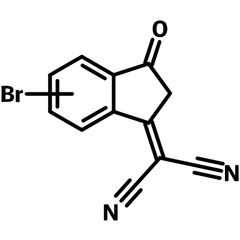BrIC
CAS Number 507484-47-1
Chemistry Building Blocks, Materials, Monomers, Non-Heterocyclic Building BlocksBrIC, used to synthesize non-fullerene acceptors for highly efficient solar cells
High purity monomer available online with free worldwide shipping on qualifying orders
Specifications | MSDS | Literature and Reviews
BrIC (CAS number 507484-47-1), also known as 2-[5(6)-Bromo-3-oxo-2,3-dihydro-1H-inden-1-ylidene]malononitrile, is a mono-brominated 3-(dicyanomethylidene)indan-1-one that is electron deficient with both carbonyl and malononitrile function groups.
BrIC can be used as an intermediate for the synthesis of non-fullerene acceptors (NFAs) such as TPT10 for highly efficient organic solar cells. Compared to fluorination and chlorination, bromination can more effectively lower the energy levels of the resulting NFA and shift the absorption spectra further into the near-infrared.
Red-shifted absorption
Bromide substituent lowers HOMO/LUMO energy levels
High purity
>98% BrIC Purity
Worldwide shipping
Quick and reliable shipping
Electron deficient end group
For the synthesis of highly efficient NFAs
General Information
| CAS Number | 507484-47-1 |
| Chemical Formula | C12H5BrN2O |
| Molecular Weight | 273.08 g/mol |
| Full Name | 2-[5(6)-Bromo-3-oxo-2,3-dihydro-1H-inden-1-ylidene]malononitrile |
| Synonyms | ICBr, 2-[5(6)-Bromo-2,3-Dihydro-3-oxo-1H-inden-ylidene]-propanedinitrile |
| Classification / Family | Malononitrile, Indanone, Monomer and intermediates, None-fullerene acceptors (NFAs), NFA-OSCs, printing electronics |
Chemical Structure

Product Details
| Purity | >98% (by NMR) |
| Melting Point | N/A |
| Appearance | Orange powder |
MSDS Documentation
Literature and Reviews
- Bromination and increasing the molecular conjugation length of the non-fullerene small-molecule acceptor based on benzotriazole for efficient organic photovoltaics, N. Zhang et al., RSC Adv., 11, 13571-13578 (2021); DOI: 10.1039/D1RA01348C.
- High Efficiency Polymer Solar Cells with Efficient Hole Transfer at Zero Highest Occupied Molecular Orbital Offset between Methylated Polymer Donor and Brominated Acceptor, C. Sun et al., J. Am. Chem. Soc., 142, 1465−1474 (2020); DOI: 10.1021/jacs.9b09939.
-
Bromination: An Alternative Strategy for Non‐Fullerene Small Molecule Acceptors, H. Wang et al., Adv. Sci (Weinh), 7(9), 1903784 (2020); DOI: 10.1002/advs.201903784..
